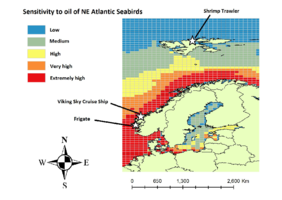The eastern North Atlantic Ocean holds large concentrations of breeding and wintering seabirds. Since November there has been three incidents in the Norwegian waters involving vessels that could have resulted in major oil spills: a frigate that collided with a Malta-registered oil tanker off Bergen in November 2018; a shrimp trawler that ran aground in north Svalbard in December 2018; and the Viking Sky cruise ship that lost power off Hustadvika in March 2019. If conditions were different, how would a major oil spill at these locations affect the wintering seabirds? We can explore this by looking at our spatial OVI map for this region for seabirds during non-breeding season. The map highlights the sensitivity of seabirds to oil spills during non-breeding season, from low to extremely high (note that this is based on seabird distributions only so it does not consider seabird densities). Looking at the incident in Svalbard, if an oil spill had occured it is unlikely to have had a major negative impact on wintering seabird populations, as we would expect, with few seabirds present in these waters at this time of year. Conversely, the incidents off Bergen and Hustadvika could have had a greater negative impact on non-breeding seabirds, due to the extremely low sensitivity of seabirds in this area. A large number of species winter off the coast of Norway and their behaviour (specifically spending a large amount of time on the water) means they are susceptible to oil spills. The species potentially affected by the oil spill would have included large numbers of Razorbill, Little Auk, Puffin, Guillemot, Common Scoter and Great Northern Diver. Fortunately, for these seabirds and other marine life, these incidents did not result in any major spills.
Recent near misses in the Norwegian waters and seabirds

Map illustrating the recent incidents and the vulnerability of the seabirds to oil (downloadable version available below the text)
